Zakuski
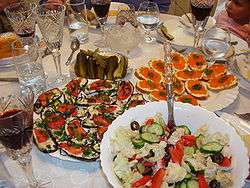 | |
| Course | Hors d'oeuvre or snack |
|---|---|
| Place of origin | Eurasia, Eastern Europe, Northern Europe |
| Main ingredients | Cold cuts, cured fishes, mixed salads, pickled vegetables, kholodets, pirozhki, hard cheeses, caviar, canapés, open sandwiches, breads |
Zakuski (plural from Russian: закуски [zɐˈkuskʲɪ]; singular zakuska from закуска) is a Slavic term for hot and cold hors d'oeuvres, entrées and snacks,[1][2] either as a course as it is or "intended to follow each shot of vodka or another alcoholic drink."[3] The word literally means something to bite after.[4]
The introduction of zakuski into Russian cuisine is usually attributed to Peter the Great who brought many cultural elements from Northern Europe to Russia. Thereby this custom was probably adopted from Swedish and Finnish brännvinsbord which was also the ancestor of modern smörgåsbord.[2] A table with zakuski was kept in the houses of the Russian gentry for feeding casual visitors who travelled long distances and whose arrival time was often unpredictable.[1] At banquets and parties, zakuski were often served in a separate room adjacent to the dining room or on a separate table in the dining room. The tradition eventually spread to other layers of society and remained in the Soviet times, but due to lack of space, they were served on the dinner table. Zakuski became thus the first course of a festive dinner.[2]
Nowadays, these appetizers are commonly served at banquets, dinners, parties and receptions in countries which were formerly part of the Russian Empire including some post-Soviet states and Poland (Polish: zakąski).[1][5] A broad selection of zakuski constitutes a standard first course at any feast table. Usually, zakuski are already laid on the table when guests are called to the dining room.[1]
Typical zakuski consist of cold cuts, cured fishes, mixed salads, kholodets (meat jelly), pirogs or pirozhki, various pickled vegetables such as tomatoes, beets, cucumbers, sauerkraut, pickled mushrooms, deviled eggs, hard cheeses, caviar, canapés, open sandwiches, and breads.[2][6]
Gallery
 Pickled cucumbers as zakuska for clear vodka
Pickled cucumbers as zakuska for clear vodka.jpg) Pirozhki, pickled tomato, mixed salads
Pirozhki, pickled tomato, mixed salads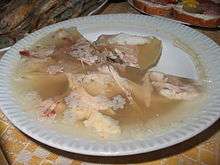
- Canapés with sprats

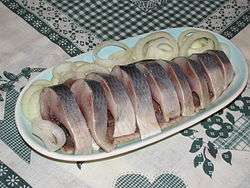
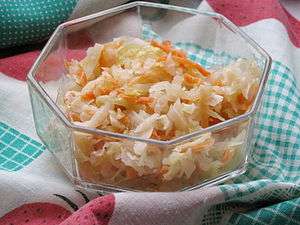
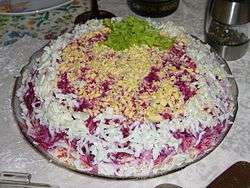
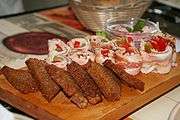 Breads with salo
Breads with salo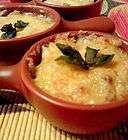 Julienne
Julienne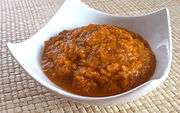 Squash spread
Squash spread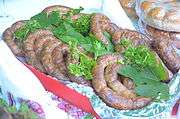 Kolbasa (sausages)
Kolbasa (sausages)
See also
References
- 1 2 3 4 "Zakuski". Culture and Customs of Russia. Greenwood Publishing Group. 2000. ISBN 9780313311017.
- 1 2 3 4 Alan Davidson (2014). "Zakuski". The Oxford Companion to Food. Oxford: Oxford University Press. pp. 889–890. ISBN 9780191040726.
- ↑ Encyclopaedia of Contemporary Russian
- ↑ Закуска. С.И. Ожегов, Н.Ю. Шведова. Толковый словарь русского языка. Азъ, 1992 (in Russian)
- ↑ Procner, Aleksandra (1999). Technologia gastronomiczna z towaroznawstwem [Gastronomic technology with commodity-knowledge] (in Polish). Warszawa: WSiP. ISBN 83-02-02789-8.
- ↑ JOC All New Rev. - 1997 - Irma S. Rombauer, Marion Rombauer Becker